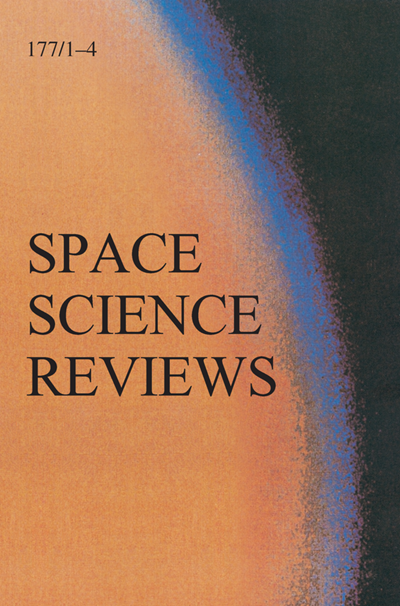金星表面的矿物学
IF 7.4
2区 物理与天体物理
Q1 ASTRONOMY & ASTROPHYSICS
引用次数: 2
摘要
地表矿物学记录了地球的主要成分、气候历史以及地表与大气之间的地球化学循环。我们还没有直接测量金星表面的矿物学,但各种独立的调查产生了对当前时代的表面组成和风化反应的基本了解,岩石在约460°C和92 bar的超临界大气中以CO 2, n2和so2为主。根据7个金星和织女登陆器的测量,覆盖约80%表面的火山平原的主要成分被推断为玄武岩,并且与形态一致。这些着陆器还记录到so3值升高,岩石密度低,赤铁矿的光谱特征与氧化环境下的化学风化一致。在当今大气条件下的热力学模型和实验室实验预测并证明了岩石中的Fe, Ca, Na主要与S物质反应形成硫酸盐,硫化物和氧化物。金星快车轨道器上的VIRTIS仪器探测到的地表发射率在~ 1 μm的变化与地质地形在空间上相关。在金星表面温度下对地质物质的近红外(NIR)发射率的实验室测量证实了理论预测,即1 μm的发射率与矿物中的铁2+含量直接相关。这些数据揭示了高辐射率的区域,可能表明未风化的和最近喷发的玄武岩,而与软质地形相关的低辐射率可能表明在更温和的时代形成的长英质物质。麦哲伦雷达发射率也限制矿物学,因为这个参数与高介电矿物的类型和体积成反比,可能是由于表面/大气反应而形成的。麦哲伦号图像中对黏性和低黏性火山流的观测也可能与成分有关。VERITAS, EnVision和DAVINCI任务收集的全球近红外发射率和高分辨率雷达和地形将为这些方法和我们对金星矿物学的理解提供革命性的进步。至关重要的是,这些数据集必须得到实验室实验的支持,以限制风化反应的类型和速率,并在金星条件下对其近红外发射率和雷达特征进行实验室测量。本文章由计算机程序翻译,如有差异,请以英文原文为准。
Mineralogy of the Venus Surface
Abstract Surface mineralogy records the primary composition, climate history and the geochemical cycling between the surface and atmosphere. We have not yet directly measured mineralogy on the Venus surface in situ, but a variety of independent investigations yield a basic understanding of surface composition and weathering reactions in the present era where rocks react under a supercritical atmosphere dominated by CO 2 , N 2 and SO 2 at ∼460 °C and 92 bars. The primary composition of the volcanic plains that cover ∼80% of the surface is inferred to be basaltic, as measured by the 7 Venera and Vega landers and consistent with morphology. These landers also recorded elevated SO 3 values, low rock densities and spectral signatures of hematite consistent with chemical weathering under an oxidizing environment. Thermodynamic modeling and laboratory experiments under present day atmospheric conditions predict and demonstrate reactions where Fe, Ca, Na in rocks react primarily with S species to form sulfates, sulfides and oxides. Variations in surface emissivity at ∼1 μm detected by the VIRTIS instrument on the Venus Express orbiter are spatially correlated to geologic terrains. Laboratory measurements of the near-infrared (NIR) emissivity of geologic materials at Venus surface temperatures confirms theoretical predictions that 1 μm emissivity is directly related to Fe 2+ content in minerals. These data reveal regions of high emissivity that may indicate unweathered and recently erupted basalts and low emissivity associated with tessera terrain that may indicate felsic materials formed during a more clement era. Magellan radar emissivity also constrain mineralogy as this parameter is inversely related to the type and volume of high dielectric minerals, likely to have formed due to surface/atmosphere reactions. The observation of both viscous and low viscosity volcanic flows in Magellan images may also be related to composition. The global NIR emissivity and high-resolution radar and topography collected by the VERITAS, EnVision and DAVINCI missions will provide a revolutionary advancement of these methods and our understanding of Venus mineralogy. Critically, these datasets must be supported with both laboratory experiments to constrain the style and rate weathering reactions and laboratory measurements of their NIR emissivity and radar characteristics at Venus conditions.
求助全文
通过发布文献求助,成功后即可免费获取论文全文。
去求助
来源期刊

Space Science Reviews
地学天文-天文与天体物理
CiteScore
19.70
自引率
3.90%
发文量
60
审稿时长
4-8 weeks
期刊介绍:
Space Science Reviews (SSRv) stands as an international journal dedicated to scientific space research, offering a contemporary synthesis across various branches of space exploration. Emphasizing scientific outcomes and instruments, SSRv spans astrophysics, physics of planetary systems, solar physics, and the physics of magnetospheres & interplanetary matter.
Beyond Topical Collections and invited Review Articles, Space Science Reviews welcomes unsolicited Review Articles and Special Communications. The latter encompass papers related to a prior topical volume/collection, report-type papers, or timely contributions addressing a robust combination of space science and technology. These papers succinctly summarize both the science and technology aspects of instruments or missions in a single publication.
 求助内容:
求助内容: 应助结果提醒方式:
应助结果提醒方式:


